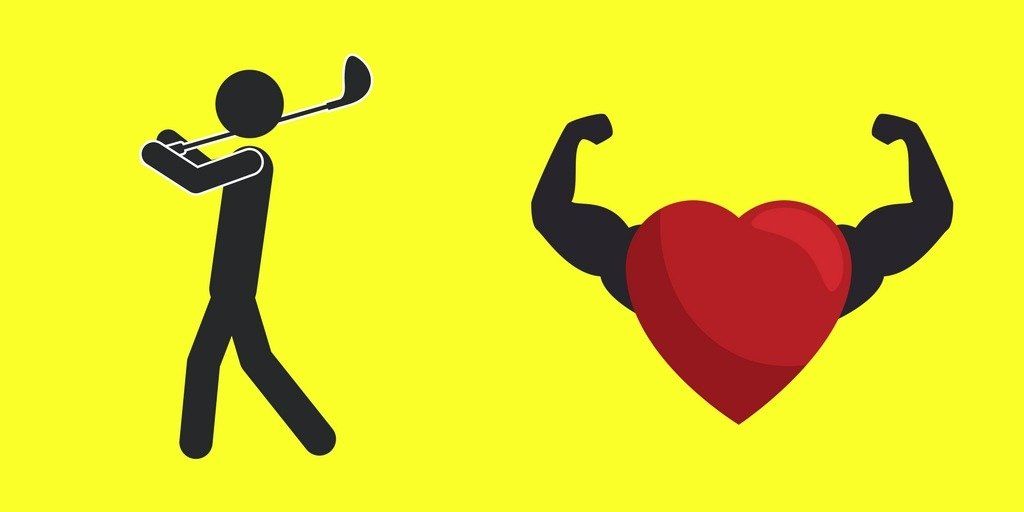
When most people think of golf, they don’t necessarily think of exercise or fitness. As someone who is deeply interested in both of those activities, I wanted to find out if I could kill two birds with one stone. Is golf exercise?
This is a question that has been lingering in the back of my head for quite some time, and I recently performed an experiment to figure out whether or not a 30-minute session of hitting balls was giving me any kind of cardiovascular benefit.
What is Considered Proper Exercise?
I have practiced some form of an exercise routine for most of my adult life, and as much as it feels like a chore sometimes, it is completely worth it.
The data is pretty astounding on what you can accomplish through consistently working out every week.
The Mayo Clinic lists these as some of the main benefits of exercise:
- Prevents excess weight gain, and helps control weight loss
- Combats health conditions and diseases like diabetes, heart disease, depression, cancer, arthritis, and strokes
- Stimulates chemicals in your brain that will make you happier
- Improves your overall energy
- Helps you sleep better
That’s a pretty solid list, and it’s actually much longer than that.
There are various recommendations on how much exercise adults need, but the basic guidelines from the American Heart Association are about 150 minutes a week of moderate exercise or 75 minutes of vigorous exercise.
They define physical activity as “anything that makes you move your body and burn calories.”
Golf certainly falls into that category, but I wanted to find out specifically what kind of exercise hitting balls could be considered.
The Test
Measuring your heart rate is the easiest way to determine how hard your body is working during any kind of fitness routine.
For my informal test I used a polar heart rate monitor with a chest strap. This method is actually far more accurate than using some of the popular fitness watches out there. I’ve looked into purchasing them before, but most models fall short of accurately measuring your heart rate during vigorous exercise.

For the test I hit balls like I normally would for about 30 minutes, and continually monitored my heart rate the whole time.
Typically my resting heart rate is about 53-55 beats per minute. I do a lot of interval training on a spin bike (which I highly recommend), and consider myself to be in pretty good shape. Usually when I’m working out I like to get my heart rate between 135 – 165 beats per minute.
So how did it go?
Throughout my entire session my heart rate was almost exactly between 97-100 beats per minute.
It certainly wasn’t high intensity, and if you use most online heart-zone calculators this would fall firmly into a "light" workout (some might not even consider it workout). I was at about 50% of my max heart rate, which is certainly on the low end. But the golf swing is a dynamic movement of your body, and I concluded that hitting balls for me personally would probably be the equivalent of a brisk walk.
I was secretly hoping for something better, maybe in the 110-120 beats per minute range, but it didn’t happen for me.
Keep in mind that everyone’s heart rate and fitness levels are completely different. You might experience varying results, but I think any casual observer would not equate a range session with a 3-mile run.
Conclusion – Hitting balls is most likely light exercise, but certainly not intense "golf exercise". It probably falls into the 150 minutes of moderate activity that the American Heart Association recommends per week.
The Real Benefit of Golf Exercise
Hitting golf balls alone probably won’t get your heart racing (unless maybe you are going nuts with your driver), but there is something else you can do in your golf game that would be considered great exercise.
You should be walking the course.
I wrote this article a while back about the benefits of walking a golf course. I actually believe for most golfers it makes your round more enjoyable, and gives you time to process your thoughts more effectively.
I walk my golf course almost every time I play. It’s extremely hilly, and I have tracked it at about a 6.3 to 6.5 mile walk using a GPS device. Between all of the practice swings, full shots, and walking with a bag on my back that could potentially burn over 1000 calories.
There was some recent data that came from the University of Edinburgh equating playing golf to health benefits. After looking through more than 5,000 studies, they have shared many of the physical and mental benefits of playing golf and how it could add over five years to your life. The Golf & Health website has more information here.
There is no question that you will derive the largest benefit by walking the course, and if it's possible for you to do at your course I would strongly encourage you to get off the cart. That is legitimate golf exercise!
We care about the protection of your data Read our Privacy Policy